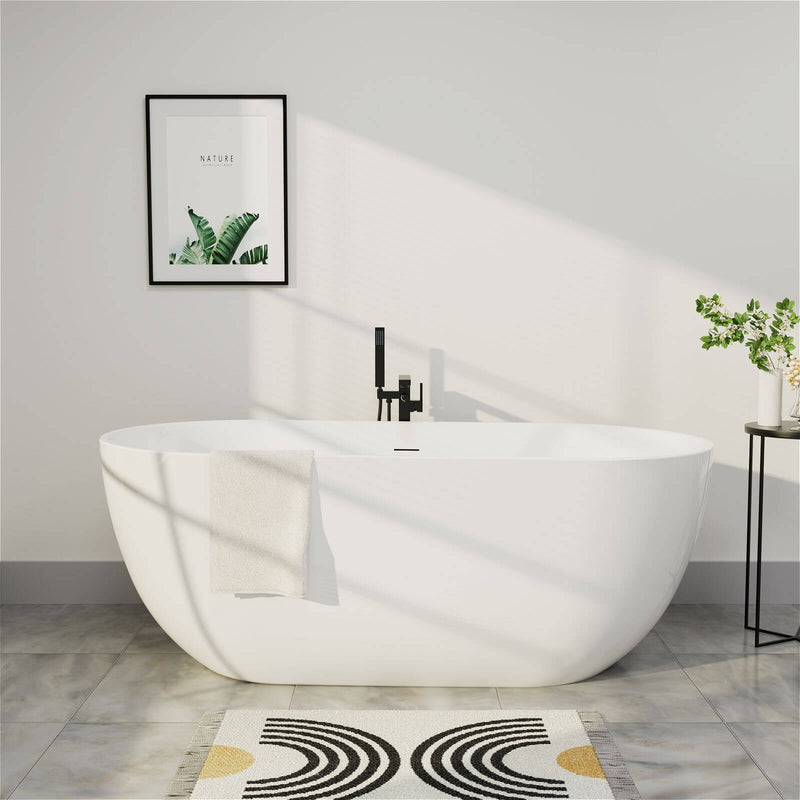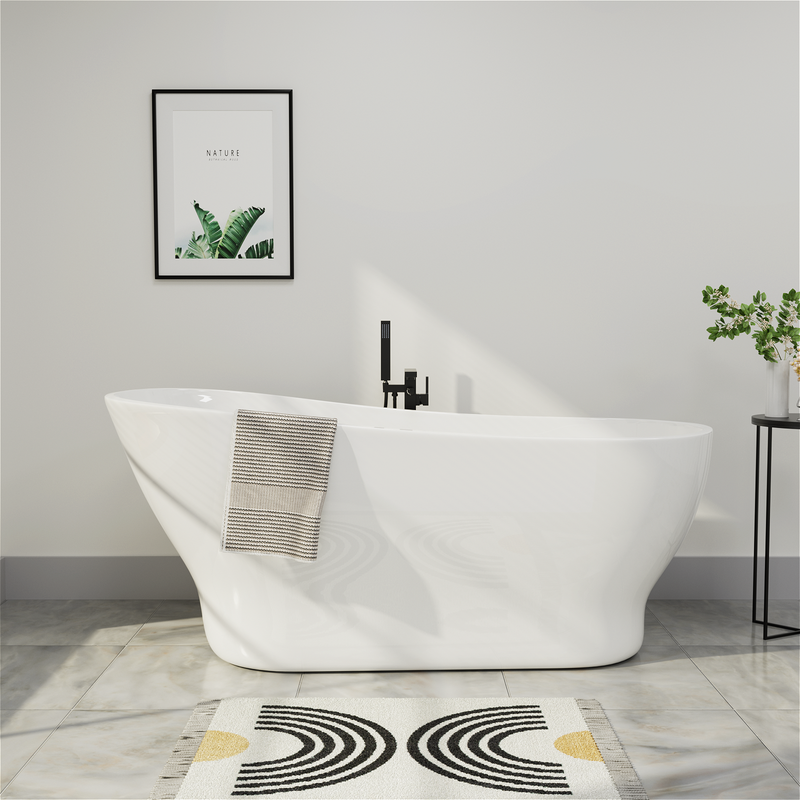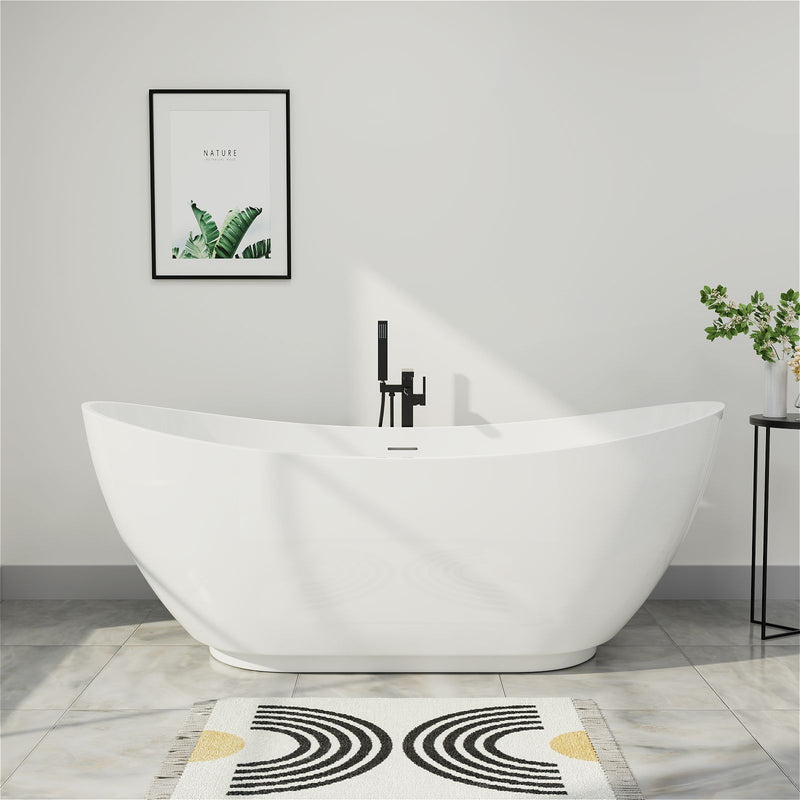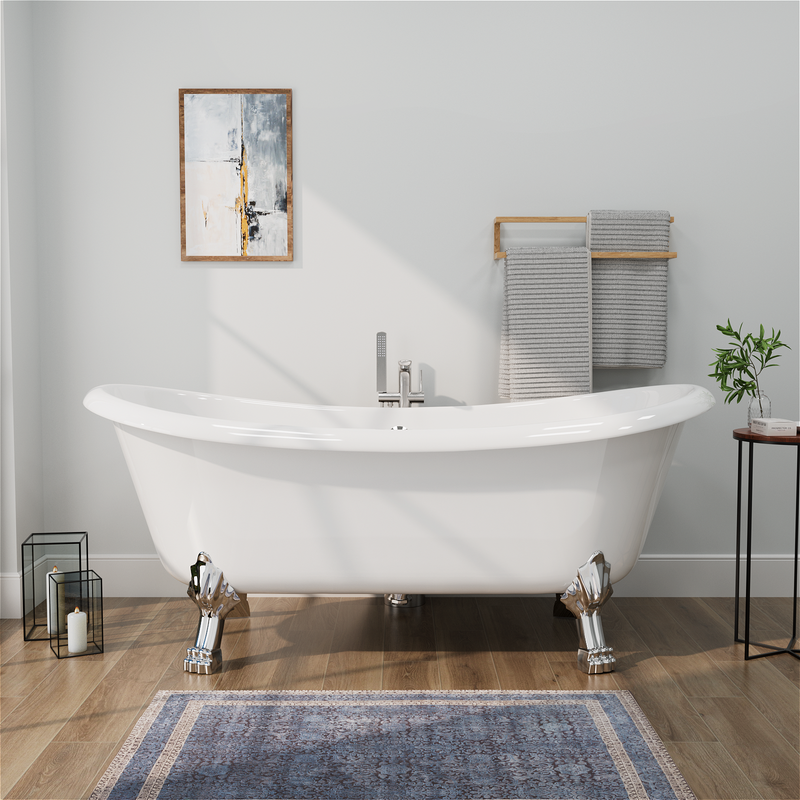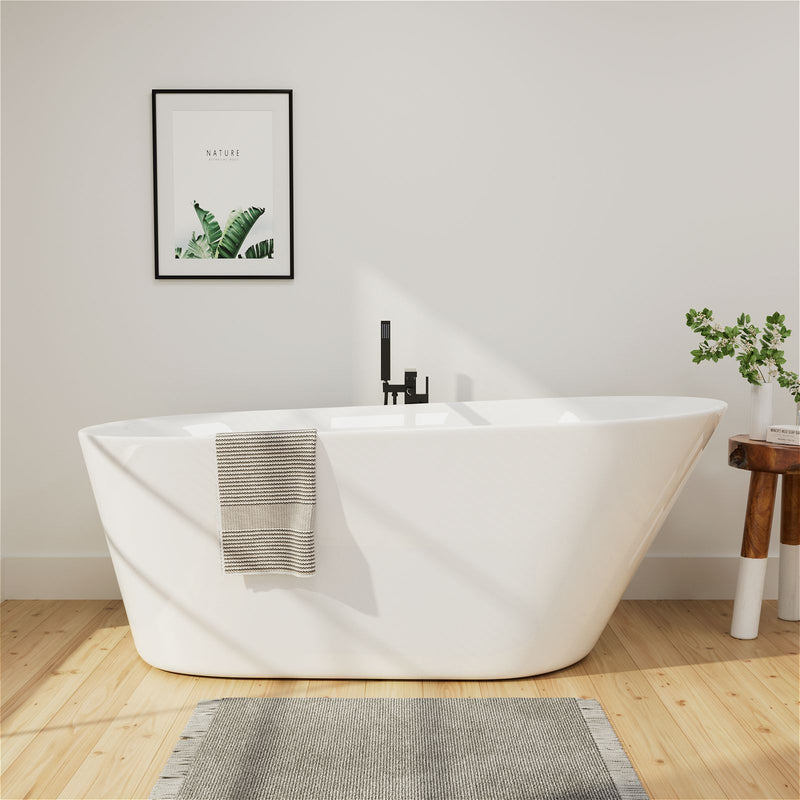There's no denying the dramatic impact a black acrylic bathtub makes in any bathroom. This striking fixture serves as a powerful focal point, radiating sophistication and modern elegance that lighter tubs simply cannot match. The deep, rich color adds depth and character to your space, transforming an ordinary bathroom into a personal sanctuary. However, owning this beautiful centerpiece comes with unique responsibilities. Unlike traditional white tubs, black acrylic surfaces can be less forgiving, showing water spots, soap scum, and minor imperfections more readily. Proper maintenance isn't just about cleanliness—it's about preserving the luxurious appearance that made you choose black in the first place.
The good news is that maintaining your black acrylic bathtub's stunning look doesn't require expensive products or complicated routines. With the right knowledge and consistent care, you can protect your investment and ensure your tub remains a captivating feature of your bathroom for years. This comprehensive guide will walk you through everything you need to know about black acrylic bathtub maintenance, from daily cleaning to addressing common issues, all while keeping your tub's glossy, dark finish looking its absolute best.
Why Black Acrylic Bathtubs Demand Special Attention
Black acrylic bathtubs possess the same material properties as their lighter counterparts, but their dark surface creates unique maintenance considerations. Acrylic is a relatively soft material compared to cast iron or steel, making it susceptible to scratches and abrasions if not cared for properly. The dark pigment in black tubs, while beautiful, acts like a canvas that highlights imperfections, water marks, and residue that might go unnoticed on lighter surfaces.

When you understand the nature of acrylic material, your approach to maintenance becomes more logical. Acrylic is a polymer that's warm to the touch, lightweight, and typically reinforced with fiberglass for stability. This composition gives it excellent heat retention properties but also makes it vulnerable to harsh chemicals, abrasive tools, and extreme temperatures. The black finish, while deeply pigmented, isn't just a surface coat on quality tubs—it's integrated throughout the acrylic material, which means proper care preserves its color integrity rather than causing fading or discoloration over time.
Daily and Weekly Cleaning Routines
Consistency is crucial when maintaining a black acrylic bathtub. Establishing simple routines prevents the buildup of stains and residues that become increasingly difficult to remove over time.
Immediate After-Use Care
The single most effective habit for maintaining your black acrylic tub is quick maintenance after each use. This doesn't need to be a thorough cleaning, but rather a simple preventative measure. While the tub is still wet from your bath or shower, use a soft rubber squeegee to remove standing water from the surfaces. Follow this by wiping the entire tub with a soft microfiber cloth or non-abrasive sponge. This quick two-minute process prevents water spots from forming, especially in areas with hard water, and reduces soap residue buildup.
For this daily maintenance, you only need plain water. If you've used bath oils or soap, you might occasionally add a small amount of mild dish soap to your damp cloth for a light wipe-down. The goal is to prevent mineral deposits and residues from having time to adhere to the acrylic surface, making your weekly cleaning significantly easier.
Weekly Deep Cleaning
Once a week, perform a more thorough cleaning of your black acrylic tub. Begin by rinsing the surface with warm water to remove loose debris. Create a cleaning solution using a few drops of gentle dish soap or a pH-neutral cleaner specifically designed for acrylic surfaces mixed with warm water. Avoid any cleaners containing harsh acids, alkalis, or abrasive particles that can damage the acrylic finish.
Use a soft sponge or microfiber cloth to gently wipe all surfaces in a circular motion. Pay special attention to areas that accumulate more residue, such as the tub bottom where foot traffic occurs, and near the drain where soap scum tends to collect. For more stubborn areas, you can let the cleaning solution sit for a few minutes before wiping, but avoid allowing it to dry on the surface.

After cleaning, thoroughly rinse the tub with clean water to remove any soap residue, then dry completely with a soft towel. This final drying step is particularly important for black tubs, as it ensures no water spots remain and gives your tub a streak-free, brilliant shine.
Proper Cleaning Tools and Products
Using the correct tools and products is essential for preserving the glossy finish of your black acrylic bathtub. The wrong choices can cause irreversible damage that diminishes its appearance.
Recommended Cleaning Tools
Soft Microfiber Cloths: These are ideal for both daily wipe-downs and weekly cleaning as they're highly absorbent and non-abrasive.
Sponges with Soft Surfaces: Choose natural sea sponges or synthetic sponges without abrasive scouring pads on the back.
Soft-Bristled Nylon Brushes: These can be useful for textured anti-slip surfaces at the bottom of the tub, but use them gently.
Products to Use
Mild Liquid Dish Soap: An excellent, gentle cleaner for weekly maintenance.
Glass Cleaner: Some sources indicate that glass cleaner can work well on acrylic surfaces.
Specialized Acrylic Tub Cleaners: Products specifically formulated for acrylic surfaces are your safest bet.
White Vinegar Solution: For periodic descaling, mix equal parts white vinegar and water, but limit this to once a month as frequent use of acidic solutions can eventually affect the acrylic's finish.
Baking Soda Paste: For tougher stains, create a paste with baking soda and water, apply gently with a soft cloth, then rinse thoroughly.
Handling Stains and Scratches
Even with meticulous care, your black acrylic tub may occasionally encounter stains or surface scratches. Addressing these issues promptly and properly will keep your tub looking its best.
Treating Common Stains
For water mineral stains or hard water deposits, a paste made from baking soda and water applied with a soft cloth can be effective. Gently rub the paste onto the stained area, let it sit for a few minutes, then rinse thoroughly. For more stubborn mineral deposits, a solution of equal parts white vinegar and water can help break down the minerals. Apply the solution, let it sit for no more than five minutes, then rinse completely. Always remember that vinegar is acidic and should be used sparingly on acrylic surfaces.
Soap scum buildup responds well to a solution of warm water with a small amount of dish soap. For persistent soap scum, you can try using a melamine sponge (magic eraser) gently, but test in an inconspicuous area first and apply minimal pressure.
Addressing Surface Scratches
Minor surface scratches on black acrylic tubs can often be repaired without professional help. For light surface scratches, try using a clean, soft cloth and non-gel toothpaste with mild abrasive properties. Apply a small amount and buff in a circular motion, then rinse thoroughly. There are also specialized acrylic polishing compounds available that can restore the shine to scratched areas.

For deeper scratches that are visible and tangible, you might need to use a very fine grit sandpaper (1000# or higher) followed by a polishing compound. This process requires patience and a light touch—always sand in one direction with plenty of water, and follow with polishing to restore the gloss. If you're uncomfortable with this approach, consider contacting a professional acrylic repair service.
Preventing Damage and Discoloration
Preventative care will significantly reduce the need for stain removal and repairs, keeping your black acrylic tub in pristine condition with less effort over time.
Avoiding Physical Damage
Never use your black acrylic tub as a cutting surface or workbench. Avoid dropping heavy or sharp objects into the tub, as acrylic can crack or chip under severe impact. When bathing children, keep metal toys that could scratch the surface to a minimum, or consider using a protective mat during playtime.
If you need to use a step stool to enter the tub, choose one with rubberized, non-slip feet to prevent scratching. Be mindful of belt buckles, zippers, or metal accessories that might come into contact with the tub surface during use.
Preventing Chemical Damage
Many common household cleaners are too harsh for acrylic surfaces. Avoid products containing chlorine bleach, acetone, ammonia, or chloroform, as these can cause discoloration, softening, or cracking of the acrylic material over time. Similarly, avoid drain cleaners that contain harsh acids or caustic agents, as these can splash onto the tub surface and cause damage.
Be cautious with bath products as well. While most soaps and shampoos are safe, some heavily dyed products or those containing certain oils might contribute to staining if left on the surface. Always rinse the tub thoroughly after using such products.
Environmental Protection
Protect your black acrylic tub from prolonged direct sunlight, which can potentially cause fading or discoloration over many years. If your bathroom receives strong direct sunlight, consider using a window treatment to filter UV rays.
Similarly, avoid placing extremely hot items directly on the acrylic surface. While acrylic is reasonably heat-resistant, extreme temperatures can cause warping or damage. Never place hot hair tools directly on the tub surface, and be mindful of lit cigarettes or other smoking materials that could mar the finish.
Drain and Plumbing Maintenance
Proper maintenance of your tub's drainage system contributes to both the functionality of your black acrylic tub and its overall cleanliness.
Preventing Clogs
Hair and soap are the primary culprits for tub drain clogs. Use a hair catcher or drain strainer to prevent these materials from entering your plumbing system. Clean the catcher after each use to maintain proper drainage. For routine drain cleaning, pour a mixture of baking soda followed by white vinegar down the drain once a month. Let it bubble for 15 minutes, then flush with hot water. This natural approach helps break down organic matter without exposing your tub to harsh chemical drain cleaners.
Deep Cleaning the Drain
If you notice slow drainage, address it promptly before it becomes a complete clog. Remove any visible debris from the drain opening manually. For more stubborn clogs, a plunger designed for tubs can often dislodge the blockage. Fill the tub with enough water to cover the plunger cup, place the plunger over the drain, and push down and up rapidly several times.

For persistent clogs, a drain snake or auger can be effective. Carefully insert the tool into the drain and rotate it to break up or retrieve the clog. Avoid using chemical drain cleaners, as they can damage acrylic surfaces and PVC pipes.
Long-Term Preservation Strategies
Beyond daily and weekly cleaning, some periodic maintenance tasks will help preserve your black acrylic tub's beauty and functionality for the long term.
Periodic Deep Cleaning
Every few months, give your tub a more thorough cleaning. Use a cleaner specifically formulated for acrylic surfaces, following the manufacturer's instructions carefully. After cleaning, consider applying a specialized acrylic protectant or car wax (paste, not liquid) to create a protective barrier. Apply a thin, even layer with a soft cloth, let it dry according to instructions, then buff gently with a clean, dry cloth. This can help repel water and prevent staining.
Inspection and Minor Repairs
Regularly inspect your tub for any signs of damage, including hairline cracks, chips, or significant scratching. Addressing these issues early can prevent them from worsening. For minor chips or cracks, consider using an acrylic repair kit designed for bathtubs. These typically include filler material and sealant that can restore the damaged area.
If you notice issues with the tub's support structure or significant damage, contact a professional rather than attempting repairs yourself. Improperly supported acrylic tubs can develop stress cracks that require complete replacement.
FAQs
Can I use bleach to clean my black acrylic bathtub?
No, it's not recommended to use chlorine bleach on black acrylic tubs. Bleach can damage the acrylic surface over time, potentially causing discoloration or weakening of the material. Instead, use milder alternatives like diluted dish soap, baking soda paste, or cleaners specifically designed for acrylic surfaces.
How do I remove hard water stains from my black acrylic tub?
For hard water stains, create a paste of baking soda and water, apply it to the stained areas, let it sit for a few minutes, then gently wipe away with a soft cloth. For more stubborn mineral deposits, a solution of equal parts white vinegar and water can be effective. Apply, let sit for no more than 5 minutes, then rinse thoroughly. Limit vinegar use to once a month to prevent potential damage to the acrylic finish.
What should I do if my black acrylic tub gets scratched?
For minor surface scratches, non-gel toothpaste can sometimes help buff out the marks. Apply with a soft cloth using circular motions, then rinse. For deeper scratches, you may need to use a specialized acrylic polishing compound or very fine grit sandpaper (1000# or higher) followed by polishing. For significant damage, consider consulting a professional repair service.
Is it safe to use magic erasers on black acrylic tubs?
Melamine foam magic erasers can be used gently on stubborn stains, but they should be used with caution. They function as micro-abrasives and can potentially dull the glossy surface if used too aggressively. Always test in an inconspicuous area first, use minimal pressure, and follow with a thorough rinsing.
How often should I clean my black acrylic bathtub?
A quick wipe-down with a soft cloth after each use is ideal for preventing water spots and soap scum buildup. A more thorough cleaning with a gentle cleaner should be performed weekly. Regular maintenance prevents the accumulation of stains that require more aggressive cleaning methods later.
Can I use abrasive scrubbers on my black acrylic tub?
No, you should avoid abrasive scrubbers like steel wool, scouring pads, or stiff-bristled brushes on acrylic surfaces. These can create scratches that are particularly visible on black tubs. Instead, use soft cloths, sponges, or microfiber towels for cleaning.
Why does my black acrylic tub show more water spots than white tubs?
Black and other dark surfaces are less forgiving when it comes to water spots and mineral deposits because they create more contrast against the dark background. This doesn't mean your black tub gets dirtier—it just makes minor residues more visible, which is why consistent drying after use is particularly important for black acrylic tubs.
Conclusion
A black acrylic bathtub is a stunning addition to any bathroom, offering a dramatic focal point that elevates your entire space. While it requires more attentive care than conventional white tubs, the maintenance needed is straightforward once you establish a regular routine. By using the proper tools and cleaners, addressing issues promptly, and incorporating simple habits like quick drying after use, you can preserve the luxurious appearance of your black acrylic tub for years to come.
Remember that gentle care is always preferable to aggressive approaches when it comes to acrylic surfaces. The few minutes you invest in proper maintenance after each use will save you significant time and effort on deep cleaning sessions later. Your black acrylic tub is designed to provide years of relaxation and aesthetic pleasure—with these maintenance practices, you'll ensure it remains as captivating as the day it was installed, continuing to enhance your bathroom's ambiance and your daily bathing experience.

